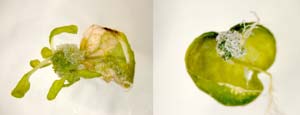Mar. 17, 2017 Research Highlight Biology
How plants shoot back
Leaves, buds and other parts of a plant shoot regenerate after wounding, thanks to a key molecular pathway
 Figure 1: Shoot regeneration occurred at cut sites only in plants that produce extra ESR1 because they have an additional ESR1 gene (left), not in those that have normal levels of the protein (right). © 2017 RIKEN Center for Sustainable Resource Science
Figure 1: Shoot regeneration occurred at cut sites only in plants that produce extra ESR1 because they have an additional ESR1 gene (left), not in those that have normal levels of the protein (right). © 2017 RIKEN Center for Sustainable Resource Science
Many plants display a remarkable ability to rebuild their tissues after being damaged. Now, RIKEN scientists have worked out the molecular processes behind this resilience1.
When a plant is cut or is subject to any physical trauma, a series of key regulators jump into action to enable new shoots to form in response to the wound stress.
Previously, Keiko Sugimoto of the RIKEN Center for Sustainable Resource Science and her colleagues had showed that a protein called WOUND INDUCED DEDIFFERENTIATION 1 (WIND1) is involved with early wound response in thale cress Arabidopsis thaliana, but it was not clear what molecules are targeted by WIND1 to promote regeneration. So they went searching for genes that were active alongside WIND1 in the plant tissue that develops over a cut. One gene in particular—ENHANCER OF SHOOT REGENERATION1, or ESR1 —caught their attention.
As its name suggests, the protein encoded by this gene promotes the regeneration of leaves, buds, stems and other parts of the plant’s above-ground shoot system. But researchers had previously shown this ability of ESR1 only when they artificially overproduced this protein.
Sugimoto’s team set out to pin down ESR1’s role under more natural conditions—when plants have experienced physical damage. When the researchers nicked the plants’ leaves with scissors they observed that WIND1 bound directly to the promoter of the ESR1 gene, boosting its expression levels.
Mutant plants that had a repressed WIND1 function exhibited problems with their regeneration capacity. These problems could be overcome by adding ESR1 (Fig. 1), indicating that ESR1 acts downstream of WIND1 to drive the repair process.
“This is the first study that links wound signaling to shoot regeneration at the molecular level,” notes Sugimoto.
This pathway is active only for the regeneration of shoots, not roots. According to Sugimoto, her team has many other candidates that might work downstream of WIND1, and they suspect that some of them promote root regeneration.
While the study focused on Arabidopsis—a model plant species—Sugimoto posits that the same pathway is active in other plants too. “Given that both WIND1 and ESR1 are well conserved in land plants, we think it is very likely that this mechanism is shared among various plant species,” she says. “We are currently testing this idea in several other plant species. We hope our discovery will help researchers develop new molecular tools to improve the regeneration efficiencies of recalcitrant plants of commercial importance.”
Related contents
- How plants self heal
- New transcription factor reveals molecular mechanism for wound-induced organ regeneration
- How plants halt hair growth
References
- 1. Iwase, A., Harashima, H., Ikeuchi, M., Rymen, B., Ohnuma, M., Komaki, S., Morohashi, K., Kurata, T., Nakata, M., Ohme-Takagi, M. et al. WIND1 promotes shoot regeneration through transcriptional activation of ENHANCER OF SHOOT REGENERATION1 in Arabidopsis. The Plant Cell 29, 54–69 (2017). doi: 10.1105/tpc.16.006
